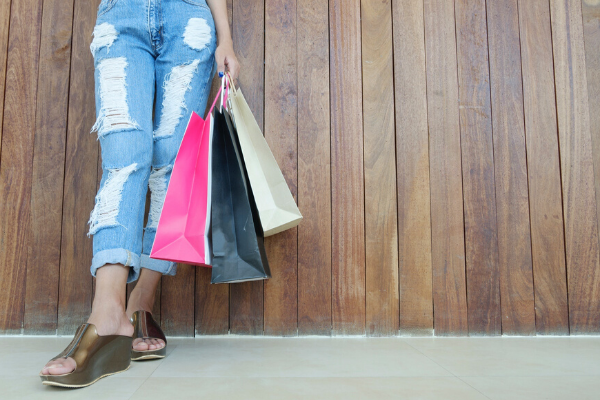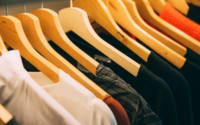Secondhand Shopping: Good for Your Wallet, GREAT for the Planet

Do you hate the idea of secondhand shopping? Do you consider using ‘old’ items a bit ‘ugh’ or gross?
Think about all the non-consumable, non-essential things that you buy – such as clothing, furniture, household items, toys. What do you do with the items you no longer want or use?
For many of us, buying new is often a default impulse whenever we need, or want, something. We might upgrade our items before they reach the end of their useful lifespan. And then we throw things in the bin and donate to charity – because often, these are the quickest and easiest options in our time-poor lifestyles to clear the clutter.
It seems pretty normal – in relatively well-off developed nations. But it’s a force of habit and ingrained behaviour from living in modern times. You can bet that your grandparents had less cash to buy stuff, and they placed more value in using goods to their full lifespan.
There are so many reasons that all of us can, and should, participate more in the secondhand economy.
For me, saving a few bucks and doing my (small) bit to help the environment are all the reasons I need to partake in the secondhand economy. If you need some convincing that secondhand shopping is for you, here’s why buying and selling secondhand is awesome.
The Benefits of the Second Hand Economy
Selling your used items online is easy
If you’ve been put-off by the idea of selling your used goods because it’s too hard, think again. It DOES takes a little of your own time, but it’s so darned easy.
Back in the days when when people only had access to ACTUAL newspapers (you know, the type printed on ACTUAL paper), you’d have to pay to put an ad in the classifieds to sell your every day household items.
But in the digital age there are so many MORE options for connecting buyers and sellers. This makes it so much more widely available and easy to buy and sell secondhand. Whether it’s eBay, Facebook Marketplace or Gumtree, the hardest thing may be to pick the best one that’ll work for you.
And because they’re often free to use, you can advertise your items for sale on various platforms, accessing a wider market and try to sell your goods faster.
Clear your house of crap stuff
I started selling items online after I had our first child. As it turns out, once you start having children, you start to accumulate a lot of stuff in your house. I mean – A LOT of stuff. Even if you try hard to buy the bare minimum, the reality is you may get gifted a lot of items from family and friends.
Whether it’s baby furniture that gets used for just a few precious months, unused kids’ toys they’ve grown bored of, unwanted gifts, and clothing that gets outgrown at phenomenal speeds (those cursed growth spurts!) – there is a market for these secondhand items. Especially if they’re lightly-used or brand new.
Even if you don’t have children – if you take a look around your house you’re sure to discover items that you no longer use, that someone else may want.
I’ve occasionally put random items up for sale, and been pleasantly surprised when they’ve actually sold. It can take time to find the right person, and you may not always get the best price for it; but you’d be amazed at what other people want to buy.
Items I’ve managed to (surprisingly) sell have included reusable baby swimming nappies (used, but a sought-after brand and still in decent condition) and incredibly ugly (at least, to me!) girls dresses (brand new, unwanted gifts)
As they say – one person’s trash is another person’s treasure.
The point is – everyone’s tastes, budget and circumstances are different. You might think it’s complete junk, but if you price it right, someone may be willing to take it off your hands. It might just be what they were looking for.
Recoup some cash
According to the Gumtree Second Hand Economy Report, 89% of Aussies have unwanted items in their home, and can potentially make $5300 from selling their unwanted goods.
Speaking for myself, I’ve sold almost $1500 worth of stuff on Gumtree in the last couple of years. For the naysayers and critics, is this enough to fund my early retirement? Ah, nope. But, IT IS $1500 that I didn’t have before, that I can put towards other things. Whatever $1500 means to you – several months of groceries, paying off some bills, or a small holiday away – I rarely hear anyone complain about having a bit of extra cash to splash.
Let’s face it, the global economy isn’t in a great place these days. Whatever the state of your finances, in my books – if you can make a bit of moolah back, that’s money you didn’t have before.
A cleaner house AND a heavier wallet? I’m all in.
Score a secondhand bargain
Still on the topic of wallet-friendly reasons, if you’re looking to buy something, instead of headed straight to the usual stores, why not have a look to see if you can find it secondhand? You may find someone selling it for a fraction of what you’d pay in-store. If you’re lucky, you might find it in lightly used, or even brand new condition. People often sell unwanted gifts, or items they’ve bought new which they then discover doesn’t completely suit their needs.
Of course, you might not be keen on buying EVERYTHING secondhand. You might legitimately have concerns about product safety or cleanliness of some types of used goods, without knowing too much about the previous owner.
But there are plenty of things that are perfectly to safe to buy secondhand. I’ve been happy to find bargains on secondhand beach sunshades, kids jigsaw puzzles, kids clothing, baby bouncers, books… there are loads of useful items available, you just need to keep an eye out for them.
Find unique items secondhand
Whether it’s a date-night dress or a new lamp for your living room, you might have a better chance of finding a one-of-a-kind item when shopping pre-loved. Vintage clothing and antiques shoppers have known this for some time.
Mass-produced goods are widely available and cheap. Big department and variety stores have big purchasing power, and scour the internet for the latest trends to copy, mass-produce and sell to the masses for cheap.
For this reason, you can expect that that cute and kitsch pastel toaster that you picked up in Kmart will be in half the homes within your neighbourhood. Or that you’ll rock up to your event to find someone wearing the same dress you snapped up on sale from ASOS last week.
It’s better for the planet
Secondhand shopping is profoundly better for the planet.
Every item that you buy new has taken up resources to get manufactured. There may be questions about whether the item was created ethically or sustainably. Unless the item is manufactured locally, it’s likely to have travelled by air or sea to get to the store or you. ALL of this has impacts on the planet.
Participating in the secondhand economy can reduce our demand on manufacturing new goods, and reduce the amount of waste headed to landfill.
Certainly, it takes some time and effort to post up items and facilitate a sale. When selling something I no longer use, I am pretty happy that I am re-homing that item with someone who wanted or needed it (and got it for a good price!).
Likewise if I can buy an item used, I’m reducing my demand on the manufacturing supply chain, and again saving that item from ending up in landfill just yet.
Secondhand shopping is not going to be the miracle answer that saves the environment or stops climate change.. But if we can start making more responsible purchasing decisions, it’s a small step in the right direction. And every small action still has an impact.
Whilst I am far from living a minimalist lifestyle just yet (still working on it!), the benefits in reducing my impact on the planet as well as saving some cash makes the extra effort in buying and selling secondhand online worthwhile.



